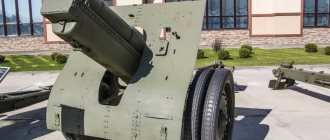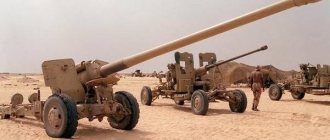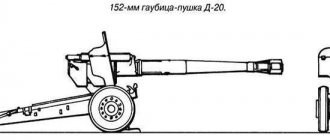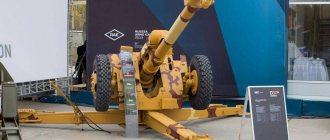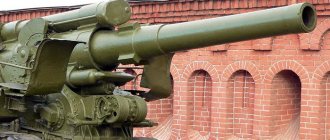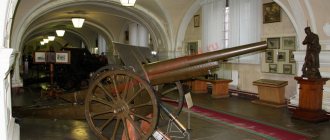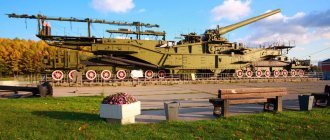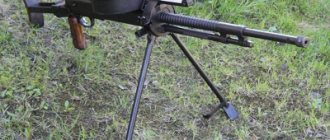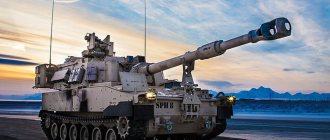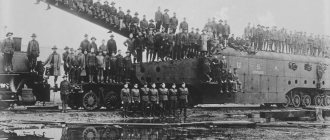Artillery. Large caliber. 122 mm howitzer model 1910/30. "Outdated" war hero
The hardest thing to talk about are guns that have been around for a long time.
In the pre-war period, in terms of this indicator, first place should be given, without hesitation, to the 122-mm divisional howitzer of the 1910/30 model. There is probably no military conflict of that time where these howitzers would not appear. And in the footage of the chronicles of the Great Patriotic War, these guns are constant heroes of battles. Moreover, you can see them from both sides of the front. The “fire” command sounds in Russian, German, Finnish, Romanian. Opponents did not hesitate to use trophies. Agree, this is a fairly important indicator of the reliability, quality and good combat characteristics of a weapon.
First of all, it is necessary to explain the historical necessity of the appearance of this particular weapon. We have already talked about the problems of the Red Army of that time. As well as about the problems of the entire USSR. Worn-out guns, lack of ability to produce high-quality spare parts, moral and technical obsolescence of weapons.
Add to this the lack of engineering and design personnel in industry, the obsolescence of production technologies, and the absence of much of what was already used in the defense industry of Western countries.
And all this against the backdrop of an openly hostile environment in the country. Against the backdrop of the West's overt preparations for war with the Soviet Union.
Naturally, the leadership of the Red Army and the USSR understood perfectly well that without taking urgent measures to rearm the Red Army, the country in the fairly near future would not only be an outsider to the world artillery powers, but would also be forced to spend huge amounts of money on the purchase of obviously outdated Western artillery systems. Modern artillery was needed here and now.
In the 1920s, the Red Army was armed with two 48-line (1 line = 0.1 inches = 2.54 mm) field howitzers: the 1909 and 1910 models. Developments (Germany) and Schneider (France). In the mid-20s, after the final transition to the metric system, it was these guns that became 122 mm howitzers.
Comparing these howitzers is beyond the scope of the authors of this article. Therefore, the answer to the question of why the 1910 model howitzer was chosen for modernization will be answered with only one comment. This howitzer was more promising and had greater potential for further modernization in terms of range.
With equal, and sometimes better (for example, in terms of the mass of a heavy high-explosive grenade - 23 kg versus 15-17 for Western models) indicators, the howitzer was significantly inferior in firing range to Western models (the German 10.5 cm Feldhaubitze 98/09 system or the British Royal Ordnance Quick Firing 4.5 inch howitzer): 7.7 km versus 9.7 km.
In the mid-20s, the understanding of the possible imminent lag of Soviet howitzer artillery was transformed into a direct order to begin work in this direction. In 1928, the design bureau of the Perm gun factory (Motovilikha) was given the task of modernizing the howitzer and increasing its range to the level of the best models. At the same time, the advantage in weight of grenades must be preserved.
The head of the design team was Vladimir Nikolaevich Sidorenko.
What is the difference between a 1930 model howitzer and a 1910 howitzer?
First of all, the new howitzer is distinguished by its chamber, which was lengthened by boring the rifled part of the barrel by one caliber. This was done in order to ensure the safety of firing new grenades. The required initial velocity of a heavy grenade could only be obtained by increasing the charge. And this, in turn, increased the length of the ammunition by 0.64 caliber.
And then simple physics. In the standard cartridge case there was either no room left for all the beams, or there was not enough volume to expand the gases formed during the combustion of gunpowder if an increased charge was used. In the latter case, an attempt to fire led to the rupture of the gun, since due to the lack of volume for the expansion of gases in the chamber, their pressure and temperature greatly increased, and this led to a sharp increase in the rate of the chemical reaction of gunpowder combustion.
The next change in the design is caused by a decent increase in recoil when fired by the new grenade. The recoil devices, the lifting mechanism and the carriage itself were strengthened. The old mechanisms could not withstand firing with long-range ammunition.
This is where the next modernization came from. Increasing the range required the creation of new sighting devices. Here the designers did not reinvent the wheel. A so-called normalized sight was installed on the modernized howitzer.
The same sights were installed on all modernized guns at that time. The only differences were in the cutting of the distance scale and fastenings. In the modern version, the sight would be called single or unified.
As a result of all the modernizations, the total mass of the gun in firing position increased slightly - 1466 kilograms.
Modernized howitzers, which today are in various museums around the world, can be recognized by their markings. Embossed inscriptions on the trunks are required: “Extended chamber.” On the carriage - “strengthened” and “arr. 1910/30" on the spindle, adjusting ring and recoil back cover.
It was in this form that the howitzer was adopted by the Red Army in 1930. Produced at the same plant in Perm.
Structurally, the 122-mm howitzer mod. 1910/30 (the main series according to the drawings “letter B”) consisted of: - a pipe barrel fastened with a casing and a muzzle or a monoblock barrel without a muzzle; - a piston valve that opened to the right. Closing and opening the shutter was done by turning the handle in one step; - a single-beam carriage, which included a cradle, recoil devices assembled in a sled, a machine tool, guidance mechanisms, a chassis, sighting devices and a shield cover.
The gun was towed by horse (six horses) or mechanical traction. The front end and charging box were required. The transportation speed was only 6 km/h on wooden wheels. Springs and metal wheels appeared after they were put into service, and accordingly, the towing speed increased.
There is one more merit of the modernized 122-mm howitzer. She became the “mother” of the Soviet self-propelled howitzer SU-5-2. The vehicle was created as part of the design of a divisional artillery triplex. The SU-5 installations were created on the basis of the T-26 tank chassis.
SU-5-1 is a self-propelled gun with a 76 mm cannon. SU-5-2 is a self-propelled gun with a 122 mm howitzer. SU-5-3 is a self-propelled gun with a 152 mm mortar.
SU-5-2
The machine was created at the Experimental Mechanical Engineering Plant named after S. M. Kirov (plant No. 185). Passed factory and state tests. It was recommended for adoption. 30 self-propelled guns were built. However, they were used to solve problems completely unusual for them.
Light tanks were intended for offensive operations. This means that tank units do not need howitzers, but assault guns. The SU-5-2 was used as an artillery support weapon. And in this case, the need for rapid movements disappeared. Transportable howitzers were preferable.
Nevertheless, these vehicles, even with such small numbers, are combat vehicles. In 1938, five self-propelled howitzers fought with the Japanese near Lake Khasan as part of the 2nd Mechanized Brigade, and the brigade command received positive feedback.
SU-5-2s also took part in the 1939 campaign against Poland. But no information about the fighting has been preserved. Most likely (considering that the vehicles were part of the 32nd Tank Brigade), it did not come to fighting.
But in the first period of the Patriotic War, the SU-5-2 fought, but did not make any special weather. In total, there were 17 cars in the western districts, 9 in the Kiev district and 8 in the Western Special District. It is clear that by the autumn of 1941, most of them were destroyed or taken as trophies by the Wehrmacht.
How did “classic” howitzers fight? It is clear that any weapon is best tested in combat.
In 1939, modernized 122-mm howitzers were used during the events at Khalkhin Gol. Moreover, the number of guns was constantly increasing. This is largely due to the excellent results of the work of Soviet artillerymen. According to Japanese officers, Soviet howitzers were superior to anything they had encountered before.
Naturally, the new Soviet systems became the subject of “hunting” by the Japanese. The defensive fire of Soviet howitzers completely discouraged Japanese soldiers from attacking. The result of this “hunt” was quite significant losses of the Red Army. 31 guns were damaged or lost forever. Moreover, the Japanese managed to capture quite a large number of trophies.
Thus, during a night attack on the positions of the 149th Infantry Regiment, on the night of July 7–8, the Japanese captured Lieutenant Aleshkin’s battery (6th battery of the 175th Artillery Regiment). When trying to recapture the battery, the battery commander died, and the personnel suffered significant losses. Subsequently, the Japanese used this battery in their own army.
The finest hour of the 122-mm howitzers of the 1910/30 model was the Soviet-Finnish war. For various reasons, it was these guns that were used to represent the howitzer artillery of the Red Army. According to some sources, the number of howitzers in the 7th Army (first echelon) alone then reached almost 700 (according to others 624) units.
Just as happened at Khalkhin Gol, howitzers became a “tidbit” for the Finnish army. The losses of the Red Army in Karelia, according to various estimates, ranged from 44 to 56 guns. Some of these howitzers also became part of the Finnish army and were subsequently used by the Finns quite effectively.
By the beginning of the Great Patriotic War, the guns we describe were the most common howitzers in the Red Army. According to various estimates, the total number of such systems reached 5900 (5578) guns. And the completeness of parts and connections was from 90 to 100%!
At the beginning of the war, in the western districts alone there were 2,752 122-mm howitzers of the 1910/30 model. But at the beginning of 1942, there were less than 2,000 of them left (according to some estimates, 1,900; no exact data).
Such monstrous losses played a negative role in the fate of these honored veterans. Naturally, new production was created for more advanced tools. Such systems were the M-30. They became the main howitzers already in 1942.
But still, at the beginning of 1943, howitzers of the 1910/30 model made up more than 20% (1400 units) of the total number of such weapons and continued their combat path. And we finally reached Berlin! Outdated, damaged by shrapnel, repaired many times, but they got there! Although it is difficult to see them on the victory chronicle. And then they also showed up on the Soviet-Japanese front.
Many authors claim that 122-mm howitzers of the 1910/30 model were outdated by 1941. And they were used by the Red Army “out of poverty.” But a simple but logical question arises: what criteria are used to determine old age?
Yes, these howitzers could not compete with the same M-30, which will be our next story. But the weapon performed its assigned tasks quite well. There is such a term - necessary sufficiency.
So, these howitzers had exactly the required effectiveness. And in many ways, the possibility of increasing the M-30 fleet in the Red Army was facilitated by the heroic work of these old but powerful howitzers.
Performance characteristics of the 122-mm howitzer model 1910/30:
Caliber, mm: 122 (121.92)
Maximum fire range of the OF-462 grenade, m: 8,875
Weight of gun in stowed position, kg: 2510 (with limber) in firing position, kg: 1466
Time to transfer to combat position, sec: 30-40
Firing angles, degrees. — elevation (max): 45 — decrease (min): -3 — horizontal: 4.74
Calculation, persons: 8
Rate of fire, rds/min: 5-6
We express our gratitude to the Museum of Russian Military History in Padikovo for the information provided.
Literature
- Sorokin A., Sliva I.
[armor.kiev.ua/wiki/index.php?title=122-%D0%BC%D0%BC_%D0%B3%D0%B0%D1%83%D0%B1%D0 %B8%D1%86%D0%B0_%D0%BE%D0%B1%D1%80._1910/30_%D0%B3%D0%B3._%D0%92_%D1%82%D0%B5%D0 %BD%D0%B8_%C2%AB%D0%BE%D0%B1%D0%B5%D0%BB%D0%B8%D1%81%D0%BA%D0%BE%D0%B2_%D1%81 %D0%BB%D0%B0%D0%B2%D1%8B%C2%BB_%D1%81%D0%BE%D0%B2%D0%B5%D1%82%D1%81%D0%BA%D0 %BE%D0%B9_%D0%B0%D1%80%D1%82%D0%B8%D0%BB%D0%BB%D0%B5%D1%80%D0%B8%D0%B8 122 mm howitzer arr. 1910/30 In the shadow of the “obelisks of glory” of Soviet artillery] // Equipment and weapons. — 2014. — No. 5,6,8,9. - Shirokorad A. B.
Encyclopedia of domestic artillery. - Mn.: Harvest, 2000. - 1156 p.: ill. With. — ISBN 985-433-703-0. - Shirokorad A. B.
God of War of the Third Reich. - M.: AST, 2002. - 576 pp.: 32 l. ill. With. — ISBN 5-17-015302-3. - Ivanov A.
USSR artillery in World War II. - St. Petersburg: Neva, 2003. - 64 p. — ISBN 5-7654-2731-6. - Shunkov V.N.
Weapons of the Red Army. - Mn.: Harvest, 1999. - 544 p. — ISBN 985-433-469-4.
Interesting facts about the M-30[edit]
- In Soviet training films for artillerymen made in the 1960s, the M-30 howitzer is very often demonstrated, despite the fact that the more modern D-30 gun of the same caliber and purpose had already been adopted for service. These films are still used in the training process of Russian artillerymen, although M-30 howitzers have not been used for a long time even as training weapons.
- A small number of combat-ready M-30s are available in the warehouses of the Russian Army at the present time.
- OF-462 shells, originally developed for the M-30, are still in service with the Russian Army and are suitable for firing from more modern guns.
- To transport the M-30, a wide variety of means were used - horse-drawn vehicles, domestic and Lend-Lease trucks, heavy Dodge jeeps (Dodge 3/4), light tracked artillery tractors "Stalinets" STZ-5 and I-12. From memoirs, even facts of rolling M-30 howitzers are known only by the forces of their calculations.
Creation stage.
In September 1937, the Artillery Department transferred the UZTM TTT design bureau for a new howitzer. As an initiative, design teams of design bureaus, head. No. 172 headed by F. Petrov and Grabinsk Design Bureau headed by. No. 92.
Plant No. 172 was the first to complete the task; its prototype howitzer with index M-30 arrived for testing at ANIOP on September 11, 1938. To reduce design time and simplify production, the design used developments in individual components of serial guns:
- The piston bolt was taken from a 122-mm howitzer mod. 1910/30;
- recoil brake, with the necessary design changes, from a 122-mm howitzer mod. 1934 (howitzer "Lubok");
- wheels from the F-22 cannon;
- The barrel bore was basically the same as that of the Lubok howitzer.
During testing, the 122-mm M-30 howitzer covered more than two and a half thousand kilometers and a little less than two and a half thousand rounds were fired from it. During the tests, the frames showed insufficient strength, which broke twice; the piston valve did not work reliably due to an error in the dimensions of the sleeves.
They could not collect a full charge of gunpowder from six differently weighted charges in one cartridge case; as a temporary measure, it was placed in a pair of cartridge cases.
The howitzer did not pass the test, but by decision of the commission it was recommended for military testing. A short time later, on November 27, 1938, the M-30, with improvements based on the results of the first tests, again entered the ANIOP. The M-30 howitzer was tested by the troops from 12/22/38 to 01/10/39. Army tests showed the same picture - weak frames, cracked welding, fluid leaks from the hydraulics.
The commission concluded that the 122-mm M-30 howitzer passed the test, there is no need for further military tests, but the identified deficiencies should be eliminated and field tests should be carried out. However, the gun underwent military testing once again, after the identified design defects were eliminated, in the summer of 1939, after which it entered service.
About the device
The howitzer design includes a carriage, a barrel, a recoil device and sighting devices. The gun is equipped with manual feeding of shells. The D-30 howitzer is an artillery gun with separate cartridge loading. The combat crew consists of six people. The gun barrel contains the following components:
- pipe;
- breech;
- removable muzzle brake;
- engaging fasteners (2 pcs.);
- gate.
On the gun barrel immediately in front of the shield there is a place for the location of a recoil device. Its presence had a positive effect on the combat operation of the howitzer. This device is represented by two metal cylinders. The first of them is a hydraulic brake, the task of which is to slow down the rollback of the gun, the second is a hydropneumatic knurler. Its function is to return the barrel to its original position immediately after the shot. According to experts, with a recoil device, the howitzer has good stability during firing. In addition, it was possible to reduce the mechanical load on the carriage, which significantly extends its service life. This nuance is important, since the weapon is heavy. The howitzer carriage consists of a cradle, a balancing mechanism, upper and lower machines, drives that provide horizontal and vertical guidance, wheels, suspension mechanisms and special fastenings. The D-30 is equipped with telescopic and panoramic sights.
Gun mount
The competition for the production of tower units was won by the St. Petersburg Metal Plant with the MK-3-12 project. The competition was attended by the Putilov and St. Petersburg Metal Plants, foreign ones: Vickers, Krupp, Skoda, Schneider-Creusot. The Obukhov plant refused to participate in the competition; the Society of Nikolaev Factories and Shipyards expressed its readiness to assemble towers according to someone else’s drawings. The MK-3-12 turret was designed by the St. Petersburg Metal Plant, and with some modifications it was put into production. The tower installation consisted of two parts, a fixed drum with a centering pin and a movable tower table with a supply pipe. The horizontal beams of the rotating part were located in the conical part, due to which the height of the tower was significantly reduced. Some original technical solutions were used in its design, such as the use of metal balls instead of rolls under the rotating table of the tower, a composite roof made of 5 armor plates. Guidance was used using electric motors with a Jenny clutch.
| Characteristics of the gun mount | Values |
| Thickness of the front inclined armor plate, mm | 203 |
| Side armor plate thickness, mm | 203 |
| Rear armor plate thickness, mm | 305 |
| Thickness of upper armor plates, mm | 76 |
| Loading range, ° | -5/+15 |
| Vertical aiming angles, ° | -5/+25 |
| 3.2 | |
| Maximum horizontal aiming speed, °/s | 4 |
| Gun mount weight, kg | 872000 |
| Weight of the rotating part, kg | 312000 |
| Rate of fire, rounds per minute | 2,2-3 |
| Number of shells per turret, pcs. | 400 |
BMW M30B35 engine tuning
M30B35 Atmo. Stroker
There are a lot of tuning spare parts for the M30, and if you have money, you can remove a few horses from it, but first, bring your engine to normal condition, if the engine asks for capital, then no shafts will help you. After restoring the M30B35, there are two ways: to make a stroker or naturally aspirated shafts. The first option involves installing a crankshaft with a piston stroke of 98 mm, short connecting rods and boring the cylinders for forged pistons of 93.4 mm. This will provide 4.0 liters of working volume, bore to 95 mm, you will get 4.2 liters, no more. The cost of such whales is higher than the cost of the entire car. Second way: you need to mill the cylinder head to increase the compression ratio to ~11, modify the channels and combustion chambers, you will also need a sports intake, a Schrick 284/280 camshaft (or another similar one) with springs, reinforced rockers, 76 mm direct-flow exhaust and a brain tune . All this will allow you to remove about 240-250 hp, but the piston is old, heavy, spins reluctantly, and it is better to replace it with light forging, add a throttle from the S38. As a result, it is cheaper to buy a BMW S38 with 340 hp throttles. and make a swap.
Turbo M30B35
BMW M30 engines from the factory have a very low compression ratio, so there is no need to decompress under boost, which means it is much easier to inflate than to make it aspirated. Buy a cheap Chinese turbo kit for the BMW M30 on eBay and install it on the stock engine. Or separately buy a Chinese Garrett GT35, with a manifold, 3-inch pipes, intercooler, wastegate, blow-off, 630 cc injectors and a Megasquirt control unit. Inflate 0.8-1 bar and get about 400 hp. Chinese turbines do not last long, several thousand km and need to be replaced. The original 35th Garrett is much better and more efficient, but the price differs significantly. Something similar can be assembled using a compressor, but with a turbine it will be more efficient.
ENGINE RATING: 4+
Caesars for the poor
What is the advantage of a wheeled self-propelled gun? Operation is cheaper, repairs are easier, roads are more intact. Even wealthy Frenchmen prefer wheeled Caesars.” And why are we any worse? - asked the Serbs.
Inspired by the success of the 155-mm wheeled self-propelled gun NORA - which is not only in service with the Serbian army, but also went to Kenya, Bangladesh and Myanmar - Serbia developed SORA with a 122-mm licensed D-30J howitzer and attached an automatic loader to it. Like a real cowboy, the self-propelled gun can fire two revolver drums of six shots in a minute. The stops recline automatically, and fire can be fired from a safe distance using the remote control. In his cartridge belt, such a gunfighter carries another 40 shots. In addition, there is a satellite communications and target designation system.
In China, the NORINCO corporation, known for many creative export projects, decided to put a howitzer on... a jeep. The howitzer, carefully copied from the Russians, was mounted on the base of a Humvee-like SUV, calling it all SH-2. The system was shown in 2007, and its 155-mm predecessor SH-1 managed to enter service with the same Myanmar. It is immediately obvious that the Burmese have a passion for wheels and howitzers.
The ubiquitous Chinese pushed the D-30 onto the ZBL-09 universal wheeled platforms, on the basis of which they built a whole line of vehicles: from armored personnel carriers to tank destroyers. The wheeled self-propelled gun entered service with the PLA, but NORINCO is actively promoting it in foreign markets.
In general, China always has several options up its sleeve. For every taste, color and budget.
“Traditional Carnation” is boring, the Ministry of Defense of Kazakhstan decided. We need weapons that would reflect our steppe spirit and correspond to the national theater of military operations! No sooner said than done by Israel. On the KAMAZ, which is not afraid of dirt, they installed the D-30 on a turntable in the promised land.
The system received a sophisticated automated fire control system. A similar one is installed on the ATMOS 2000. By the way, it is on the ATMOS that Israel replaces the old American M109 tracked ones.
All this was called Semser (“sword” in Kazakh). Soon, eighteen swords entered service with the Kazakh army. But everything went smoothly on the paper of the signed agreement. The system was not as fast as expected. There is information that at this moment some of the self-propelled guns are not ready. And some contract participants are being searched with dogs and Interpol. But, excuse me, is there even a military contract without cutting?
In Iran, there is also a fashion for gun carriages: sanctions, an arms embargo and a modest military budget contribute. We take the D-30 with an automatic loader, like the Serbs, and the KrAZ-5352. We get SAUKheidar-41” with a rate of fire of up to 15 rounds per minute.
In Algeria, which is actively arming itself - one of the best clients of the Russian defense industry - they also came up with such a simple idea and executed their variation of the D-30 in a truck with four outriggers and charging boxes on the sides.
In Sudan they decided to reserve the KamAZ-43118 wheelbase. Khalifa GHY02 received a D‑30 swinging part.
Shooting is carried out with the stops lowered, and 45 shots are placed in the charging boxes. The installation was first presented at IDEX-2013.
Instructions for using mastic for joints
Preparation of the working mixture
152 mm gun-howitzer d-20
The components of the thiokol sealant U-30M GOST 13489-79 in Kazan and Naberezhnye Chelny are mixed directly on site before its use, since after mixing the irreversible process of vulcanization of the sealant begins. The viability of U-30M thiokol construction sealant ranges from 2 (two) to 9 (nine) hours and depends on the batch of sealant, the dosage of vulcanizing agents and environmental conditions.
To prepare U-30M mastic GOST 13489-79, it is necessary to add a hardening paste and a vulcanization accelerator to the main paste in the ratio specified in the passport. Then thoroughly mix all three components until a mixture of uniform color is obtained (without streaks) using a low-speed mechanical mixer (drill), or manually using other available means.
The exact dosage of components is indicated in the passport for each specific batch of U-30M sealant.
Dimensions of the gun
German 150 mm heavy field howitzer sfh 18
The gun has very impressive dimensions: its length is almost 13 meters in the stowed position, but in combat this figure is slightly less - approximately 12.5 m. The height of the barrel in the stowed position is 2760 millimeters. The ground clearance of the two-axle chassis is 475 millimeters. The stroke width is 2340 millimeters. The diameter of each of the four wheels is 1080 millimeters, and the tire width is 300 millimeters.
The operating pressure in the tires should be maintained at 4.8 kgf/cm², the spring travel should be approximately 150 mm. The Giatsint-B howitzer weighs about 9,800 kilograms. The maximum firing range of high-explosive fragmentation shells is 28.5 kilometers. What other distance can the Hyacinth shoot? The howitzer, whose firing range under normal conditions reaches 25-28 thousand meters, can fire at a distance of up to 41 kilometers when using modern rockets.
All this allows us to say that the weapon, which began to be developed back in the 60s of the last century, is still distinguished by its impressive effectiveness on the battlefield.
